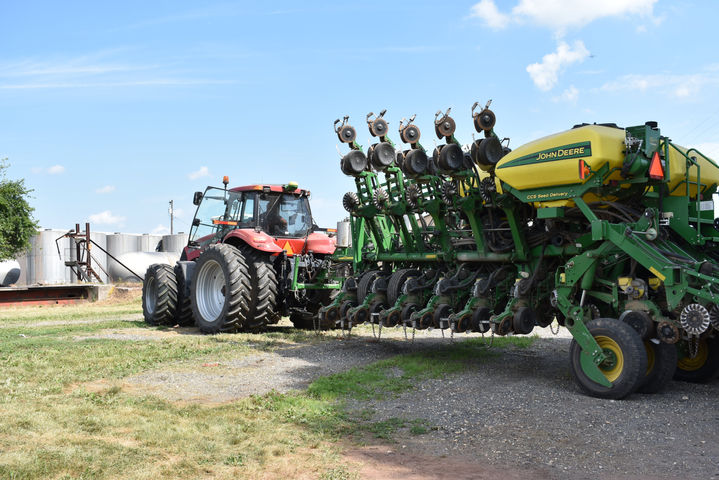
Montgomery Soil Conservation District
Montgomery County, Maryland
Celebrating the 50th Anniversary
of No-Till Ag
On July 20, 2018, the MSCD was extremely pleased to join over 120 County farmers and officials to celebrate the 50th anniversary of no-till conservation agriculture in Montgomery County.
Along with staff from the Montgomery County Office of Agriculture, the University of Maryland Cooperative Extension Office, the Maryland Department of Agriculture, and county farmers, we gathered at the county fairgrounds to celebrate and honor those farmers who have helped implement this important practice in our area. We especially honored Bob Raver, who was the Extension agent to begin no-till agriculture in Montgomery County fifty years ago. During the recognition ceremony and luncheon Bob was honored with a County Council Proclamation presented to him by Councilmen Rice and Katz and a Secretary’s Citation from the Maryland Department of Agriculture. During the Council Proclamation, Bob Raver was honored with the distinction of being officially recognized as the father of no-till agriculture in Montgomery County.
What is No-Till and Conservation Agriculture?
Conservation agriculture, in short, involves minimal disturbance of the soil. This is accomplished by avoiding tilling the land. No-till agriculture leads to: greater biodiversity, increased water efficiency, improved sustainable crop production, increased nutrient count, and a diversification of plant species.
A more formal definition from Purdue University: "The soil is left undisturbed from harvest to planting except for strips up to 1/3 of the row width (strips may involve only residue disturbance or may include soil disturbance). Planting or drilling is accomplished using disc openers, coulter(s), row cleaners, in-row chisels or roto-tillers. Weed control is accomplished primarily with crop protection products."
There are multiple types of conservation agriculture:
-
No-till
-
Strip till
-
Mulch till
-
Rotational tillage
-
Ridge-till
-
Zone tillage
A Demonstration...
As part of the celebration event, Jamie, Kathy, Mike, Pat, and Joe Jamison from Jamison Ag and Turf Farm were kind enough to give us a presentation and demonstration of no-till agriculture. The Jamisons answered questions from the crowd and discussed how and why conservation tillage works, then demonstrated for us on one of their fields what this type of agriculture looks like.
Honoring Bob Raver
We especially wanted to honor retired Extension agent Bob Raver. Bob was instrumental in bringing conservation tillage to Montgomery County around 1967-1968. No-till agriculture began in Kentucky in 1962, and shortly thereafter Bob visited Kentucky to learn more. He was so impressed that he convinced a Montgomery County farmer to buy a no-till machine. It worked so well and the feedback was so positive that Bob continued to instruct farmers and agents on the practice, so much so that Montgomery County farmers now almost entirely practice conservation and no-till agriculture. This has made Montgomery County the leading county in the nation for this practice.
At the event, County Councilmembers Craig Rice and Sidney Katz shared a proclamation declaring Bob as the Father of No-Till Agriculture in Montgomery County.
Congratulations, Bob, and thank you for all that you have done!

The Montgomery County Council created this wonderful video below to honor Bob and highlight his farming contributions.
More on the History of No-Till
During the 1960s, conventional tillage was viewed as the gold standard for cultivating corn across the United States. During this time, Montgomery County farmers found their yields well below the average production for the State. With farm profitability hanging in the balance, developers began eyeing Montgomery County farmland for developmental purposes.
This troubled Robert “Bob” Raver, now retired County Extension Agent, so much that he began researching new methods that could help increase farm yields as well as overall farm profitability. Through this research, he learned about a new, no-till planting method that not only could help increase yields by reducing the tillage of farm fields but also resulted in numerous other benefits. These benefits included creating a more efficient and sustainable means to produce commodity crops while conserving soil moisture, protecting soil from erosion, and greatly improving water quality in the County.
Seeing this as an important initiative, he took a trip to observe this new reduced tillage method being put into practice. Bob was so impressed that it inspired him to bring conservation tillage or no-till to farmers in Montgomery County.
In 1968, Bob and Tom Kelly, a local farmer, teamed up to plant the County’s first no-till field. Bob remarked that this first planted field looked pretty good and it was enough to convince 17 new farmers to try this new technology the following year. It didn’t take long for the benefits of conservation tillage to be realized. By 1979, corn yields had improved by nearly 30 bushels per acre, raising the County above the Statewide average and putting them on par with Eastern Shore farmers. The rest, as they say, is history.
One thing is for certain, the impacts of conservation tillage cannot be understated. Its acceptance and its implementation as the preferred planting method by farmers has not only been responsible for protecting our precious soil resources but has aided greatly in improved soil health and has contributed to the economic well-being of the Agricultural Reserve in Montgomery County. “This method of farming that we started here, I think, is what helped make us so healthy and I think we’re going to continue growing for a long time.” Raver said. “When I drive around the County and I see all the good growing crops and seeing all the land that is still in agriculture, it is a very satisfying thing for me.”










